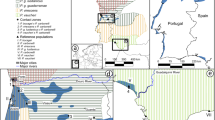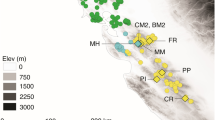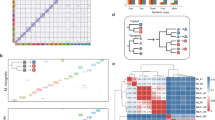Abstract
A new approach for estimating genetic identity values was applied to a data set on allozyme variation in the weevil, Otiorhynchus scaber (Coleoptera: Curculionidae). This species complex contains sexuals and different races of polyploid asexuals. The results were used to reanalyse the phylogenetic relationship among races and to discuss the monophyletic versus the polyphyletic origin of parthenogenesis. A polyphyletic origin of parthenogenesis was suggested based on the assumption of hybridization between related species, and the extinction of an ancestral species. The genetic diversity among the different races was compared. A decreased number of new mutations with increased ploidy level was found among current populations. This correlation was explained by a lower evolutionary rate in polyploid asexual races than in diploid sexual races.
Similar content being viewed by others
Article PDF
References
Crow, J F, and Temin, R C. 1964. Evidence for the partial dominance of recessive alleles in natural populations of Drosophila. Am Nat, 98, 21–33.
Glesener, R R, and Tilman, D. 1978. Sexuality and the components of environmental uncertainty: clues from geographic parthenogenesis in terrestrial animals. Am Nat, 112, 659–673.
Jaenike, J. 1978. An hypothesis to account for the maintenance of sex within populations. Evol Theory, 3, 191–194.
Lokki, J, Suomalainen, E, Saura, A, and Lankinen, P. 1975. Genetic polymorphism and evolution in parthenogenetic animals. II. Diploid and polyploid Solenobia triquetrella (Lepidoptera: Psychidae). Genetics, 79, 513–525.
Maynard Smith, J. 1978. The Evolution of Sex. Cambridge University Press, Cambridge.
Nei, M, Stephens, J, and Saitou, N. 1985. Methods for computing the standard errors of branching points in an evolutionary tree and their application to molecular data from humans apes. Molec Biol Evol, 2, 66–85.
Pamilo, P. 1990. Statistical test of phenograms based on genetic distances. Evolution, 44, 689–697.
Parker. Jr, E D, Walker, J M, and Paulissen, M A. 1989. Conal diversity in Cnemidophorus: Ecological and morphological consequences. In: Dawley, R. M. and Bogart, J. B. (eds) Evolution and Ecology of Unisexual Vertebrates, Bulletin 466, New York State Museum, Albany, New York, pp. 72–86.
Saura, A, Lokki, J, Lankinen, P, and Suomalainen, E. 1976. Genetic polymorphism and evolution in parthenogenetic animals. III. Tetraploid Otiorhynchus scaber (Coleoptera: Curculionidae). Hereditas, 82, 79–100.
Sokal, R R, and Sneath, P H A. 1963. Principles of Numerical Taxonomy. Freeman, San Francisco.
Stearns, S C. 1987. The Evolution of Sex and its Consequences. Birkhäuser Verlag, Basel, Boston.
Suomalainen, E. 1961. On morphological differences and evolution of different polyploid parthenogenetic weevil populations. Hereditas, 47, 309–341.
Suomalainen, E, and Saura, A. 1973. Genetic polymorphism and evolution in parthenogenetic animals. I. Polyploid Curculionidae. Genetics, 74, 489–508.
Suomalainen, E, Saura, A, and Lokki, J. 1987. Cytology and Evolution in Parthenogenesis. CRC Press, Boca Raton, Florida.
Templeton, A R, Carson, H L, and Sing, C H F. 1976. The population genetics of parthenogenetic strains of Drosophila mercatorum. II. The capacity for parthenogenesis in a natural bisexual population. Genetics, 82, 527–542.
Tomiuk, J, and Graur, D. 1988. Nei's modified identity and distance measure and their sampling variances. Sys Zool, 37, 156–162.
Tomiuk, J, and Loeschcke, V. 1991. A new measure of genetic identity between populations of asexual and sexual species. Evolution, 45, 1685–1694.
Vrijenhoek, R C. 1984. Ecological differentiation among clones: the frozen variation model. In: Wöhrmann, K. and Loeschcke, V. (eds) Population Biology and Evolution, Springer Verlag, Heidelberg, New York, pp. 217–231.
White, M J D. 1973. Animal Cytology and Evolution, 3rd edn. Cambridge University Press, Cambridge.
White, M J D. 1978. Modes of Speciation. Freeman, San Francisco.
Williams, G C. 1975. Sex and Evolution. Princeton University Press, Princeton, New Jersey.
Author information
Authors and Affiliations
Rights and permissions
About this article
Cite this article
Tomiuk, J., Loeschcke, V. Evolution of parthenogenesis in the Otiorhynchus scaber complex. Heredity 68, 391–397 (1992). https://doi.org/10.1038/hdy.1992.58
Received:
Issue date:
DOI: https://doi.org/10.1038/hdy.1992.58
Keywords
This article is cited by
-
Can resource costs of polyploidy provide an advantage to sex?
Heredity (2013)
-
Maintenance of clonal diversity in Dipsa bifurcata (Fallén, 1810) (Diptera: Lonchopteridae). II. Diapause stabilizes clonal coexistence
Heredity (2004)
-
Genetic identity combining mutation and drift
Heredity (1995)
-
Genetic structure and phyletic relationships of eastern mediterraneanBacillus atticus brunner (insecta phasmatodea): A biochemical study
Biochemical Genetics (1993)



